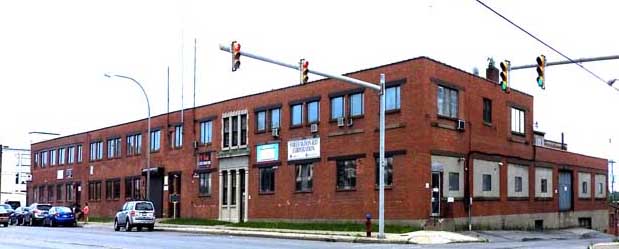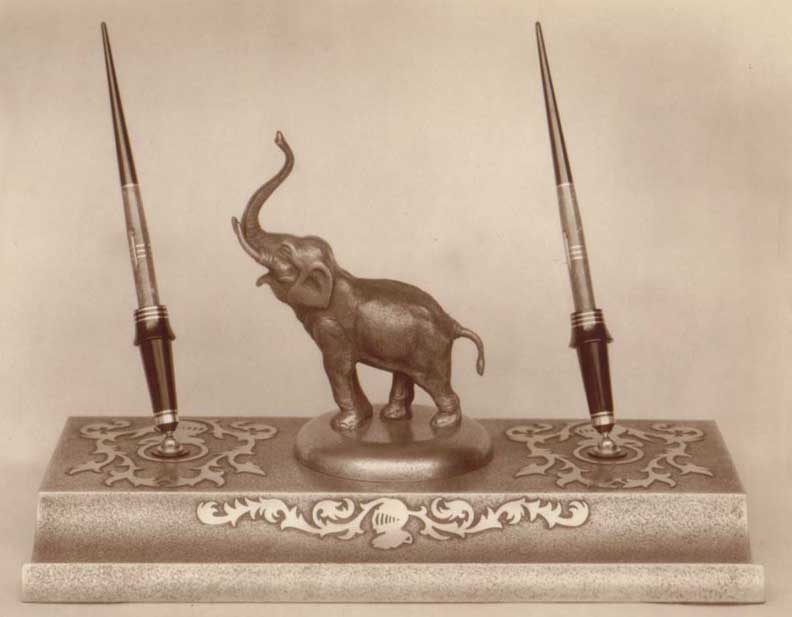
1246-1270 Niagara Street
Built by Sterling Engine Company
1907-1925 ...
Sometime in the late 1950s Sterling Engine was purchased by Phillips
Petroleum Company of Bartlesville, Oklahoma. Phillips Petroleum moved
Sterling Engine’s production facilities to Paola, Kansas, and left a
large gap on Niagara Street. ...
Resurgence
Brewing Co.'s address is #1250 ...
Love in Motion Yoga's address is #1250 (Website online September 2017)
... Bootleg Bucha's address is
#1250 (Website online
September 2017)
Five Smith McDonald facade
details below:

Smith McDonald facade detail #1 ... Note
entrance (photo below:)

Facade detail #2 ... Entrance, including entablature
above Tuscan
pilasters

Facade detail #3 ... Entrance entablature frieze

Facade detail #4

Rear of Sterling Engine Company/Smith McDonald building
... Street at right:
Mason Street which is parallel to Niagara St.
... Street at bottom: Auburn Avenue

View from Auburn Avenue looking south ... Left:
Sterling Engine Company/Smith McDonald building, ... Right:
Former Sterling
Engine Company, 42 Breckenridge Street ...
Center background: Rich Products
Corporation, 1200 Niagara Street

View
of Auburn Avenue from Niagara Street ...
Building at left is the Sterling Engine Company/Smith McDonald
building ... Building at right is the Buffalo Gasolene Motor Co./Starks
Associates

Sterling Engine north elevation (Auburn Ave.)

Niagara Street on left ... Auburn Avenue
at bottom of photo
|
Niagara
Street Facade



Peter Porter
... Porter's
house ... Cf., Robert "Frankie" Franklin
plaque: Where Porter fled during the First Battle of Black Rock
|
|
Reprint
Buffalo History: An Urban Battlefield?
By Chris Brown
Buffalo
Rising, August 20, 2009 (online July 2017)
It’s hard to believe that this nondescript two-story brick industrial
building located at 1270 Niagara Street (at the corner of Auburn
Avenue), sits at one of Buffalo’s most historic sites. It is, and it
perfectly represents the challenge that volunteers face as they plan
the commemoration of the War of 1812 in Buffalo and Erie County.
It was on this
site where Peter Buell Porter lived, one of Black
Rock’s most famous residents. While most people know that the British
burned Buffalo to the ground in December 1813, fewer know that the
British invaded in July 1813, but were successfully repelled during
what is referred to as the First Battle of Black Rock.
s
Peter Porter was an American lawyer, soldier and politician, who served
as Congressman, member of the Erie Canal Commission, and was U.S.
Secretary of War. When Porter’s house was located on this site, it was
set back from the street and had two entrances. The back of the house
had grounds that extended all the way to the Niagara River. The front
of the house faced the Niagara Street side.
The British landed near Squaw Island and invaded the military outpost
located along the Scajaquada Creek. They continued to march south
towards Buffalo. The British entered Porter’s house from the back, but
Porter was able to escape through the Niagara Street side, wearing only
his linen nightshirt. Porter, who was 40 years old at the time, ran
down Niagara Street to the home of Robert Franklin near Connecticut
Street. Franklin, an African American, loaned his horse to Porter, who
then rode to Buffalo and assembled a militia of Buffalo citizens and
Seneca Native Americans who fought along with army regulars. It was the
first time that the Senecas fought alongside the Americans.
The U.S. assembled defense met the British on Niagara Street near
Albany Street and drove them back before they could get to Buffalo.
Heavy fighting took place on what is now Mason Street, just
west of Niagara Street between Breckenridge Street and Auburn Avenue.
The British retreated after suffering heavy
losses (between 100 and 300 men) and their commander, Col. Cecil
Bishop, was killed.
Porter’s house was destroyed six months later, when the British
returned to burn Buffalo and Black Rock. The house was rebuilt after
the war (although not occupied by Porter) and occupied until it was
demolished in 1912 in order to construct the building currently on the
site.
Currently,
the Erie County War of 1812 bicentennial commemoration
planning group is working with planning groups from Canada and Niagara
County (US). The Erie County group is determining how to re-create a
sense of place for historic sites, such as 1270 Niagara Street, that
were so extensively redeveloped during the late 19th and 20th
centuries.
|

American manufacturer and retailer of office
accessories, desk pads, and wastebaskets.

Source: McDonald
Products: Smith Metal Arts (online September 2017)
|
Smith Metal Arts was founded in Buffalo, NY in 1889 by German
immigrant and metal and leather goods craftsman Otto Heinz,
as the Heinz Art Metal Company, who began as a manufacturer of desk
blotters, pen and letter holders, envelope sealers and ink blotters,
and later developed the first “lay-flat” page type of desktop calendar
base.
Following Heinz’s death in 1919, the company was purchased by Frederick
Smith,
their top salesman, and through collaboration with jewelry designer,
Peter Muller-Munk, eventually evolved into the manufacture of
“designer” lines of desk and office accessories and accoutrements.
In fact, many Smith Metal Arts products in an Art Deco motif or with
the SMA Silver Crest remain collector’s items today. A later
collaboration with Skidmore, Owings and Merrill led to the design of a
line of accessories known simply as the “202” series. This series
became the de-facto standard architectural and design specification for
almost every contemporary office in the United States, and remains on
permanent display at the Museum of Modern Art in New York City. I
In more recent years, our collaboration with noted designer William
Sklaroff has resulted in the development of many of the beautiful
accessory collections which continue to remain a popular and integral
part of our product line today.
- McDonald Products:
About Smith Metal Arts (online July 2017)
|













